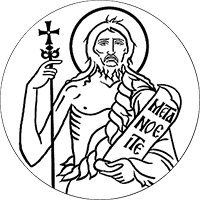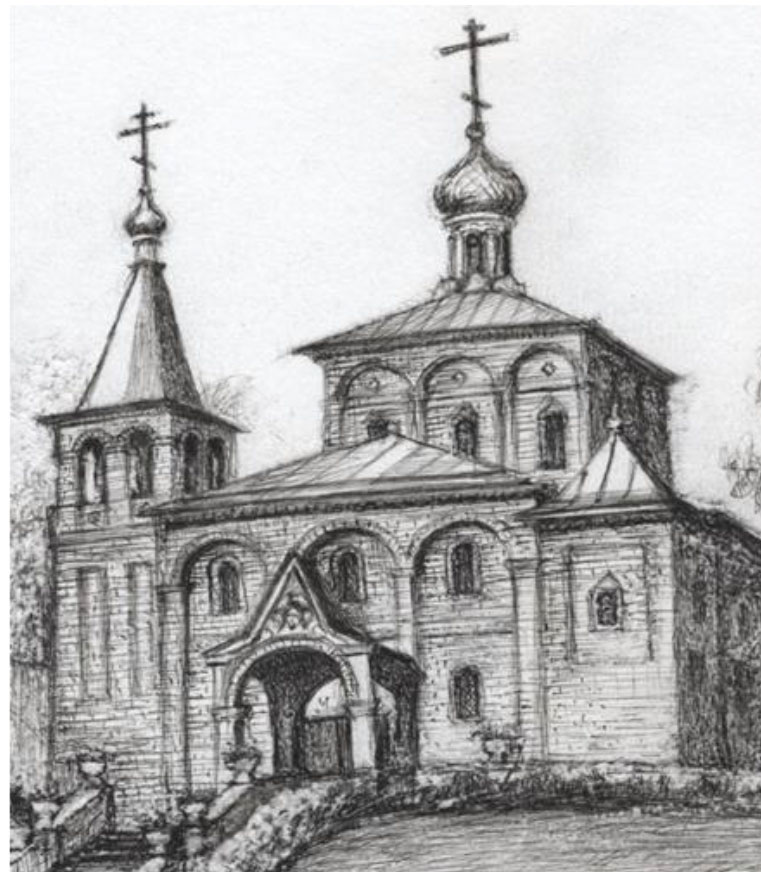You are here
The Beheading of the Glorious Prophet, Forerunner, and Baptist John

And king Herod heard of him; (for his name was spread abroad:) and he said, That John the Baptist was risen from the dead, and therefore mighty works do shew forth themselves in him. Others said, That it is Elias. And others said, That it is a prophet, or as one of the prophets. But when Herod heard thereof, he said, It is John, whom I beheaded: he is risen from the dead. For Herod himself had sent forth and laid hold upon John, and bound him in prison for Herodias' sake, his brother Philip's wife: for he had married her. For John had said unto Herod, It is not lawful for thee to have thy brother's wife. Therefore Herodias had a quarrel against him, and would have killed him; but she could not: For Herod feared John, knowing that he was a just man and an holy, and observed him; and when he heard him, he did many things, and heard him gladly. And when a convenient day was come, that Herod on his birthday made a supper to his lords, high captains, and chief estates of Galilee; And when the daughter of the said Herodias came in, and danced, and pleased Herod and them that sat with him, the king said unto the damsel, Ask of me whatsoever thou wilt, and I will give it thee. And he sware unto her, Whatsoever thou shalt ask of me, I will give it thee, unto the half of my kingdom. And she went forth, and said unto her mother, What shall I ask? And she said, The head of John the Baptist. And she came in straightway with haste unto the king, and asked, saying, I will that thou give me by and by in a charger the head of John the Baptist. And the king was exceeding sorry; yet for his oath's sake, and for their sakes which sat with him, he would not reject her. And immediately the king sent an executioner, and commanded his head to be brought: and he went and beheaded him in the prison, And brought his head in a charger, and gave it to the damsel: and the damsel gave it to her mother. And when his disciples heard of it, they came and took up his corpse, and laid it in a tomb. (Mark 6: 14-29)
Troparion
The memory of the just is celebrated with hymns of praise, but the Lord's testimony is enough for thee, O Forerunner for thou wast shown to be more wonderful than the Prophets since thou wast granted to baptize in the running waters Him whom thou didst proclaim. Then having endured great suffering for the Truth, thou didst rejoice to bring, even to those in hell, the good tidings that God Who had appeared in the flesh takes away the sin of the world and grants us the great mercy.
Kontaktion
The beheading of the glorious Forerunner was a divine dispensation that the coming of the Savior might be preached to those in hell. Lament then, Herodias, that thou didst demand a murder despising the law of God and eternal life.
Glorification
We magnify thee, O John, thou baptizer of the Savior, and we venerate thine honorable be heading.
In the Gospels, the Holy Evangelists Matthew and Mark (Matthew 14:1-12; Mark 6:14-29) tell us of the martyrdom of the Forerunner of the Lord in the 32nd year following Christ’s Nativity. Preserved in the Holy Tradition of the Apostolic Church are certain details of those events, which took place shortly before the Crucifixion and Resurrection of Christ. After the death of Herod the Great, the Romans divided Palestine into four parts, and selected four individuals to govern those territories. Herod Antipas was given rule over Galilee. He had a legal wife, the daughter of Arabian King Aretas. Herod divorced her, and cohabited with Herodias, his brother’s wife. More than once, the Holy Prophet John denounced him for that act, but the king did not dare to cause him harm, for he held John the Baptist in great respect, and was afraid of angering the populace. Yet, St. John the Baptist was imprisoned by King Herod (Luke 3:19-20). On his birthday, Herod hosted a great feast, at which Herodias’ daughter Salome danced for the guests. Her dancing so pleased Herod that in front of his guests, he swore to give her anything she asked. Salome asked her mother for advice on what to request. Herodias instructed her daughter to ask for the head of St. John the Baptist. Herod was sorrowful, for he feared God’s wrath over the murder of His prophet; however, he could not break the oath he had so carelessly sworn. St. John the Baptist was beheaded, and his head was given to Salome. According to tradition, the head continued to denounce Herod and Herodias. In a frenzy, Herodias pierced the Prophet’s tongue with a pin, and buried the head in a filthy place. However, Joanna, wife of the royal steward Khuza, secretly took away the holy head, put it in a container, and buried it in one of Herod’s estates on the Mount of Olives. St. John’s disciples took his body away for burial. God’s wrath was visited upon those who had dared to harm the Prophet. In winter time, Salome was crossing the Sikoris River, and fell through the ice. Her body hung in the water, while her head remained above the surface of the ice. Just as she had once danced upon the ground, she now appeared to be dancing, as she helplessly thrashed about in the ice-cold water. She hung that way until the sharp ice cut through her neck. Her severed head was brought to Herod and Herodias, just as the head of St. John the Forerunner had once been brought to them. Her body was never found. To avenge the dishonor visited upon his daughter, wife of Herod the Tetrarch, King Aretas launched his armies at the impious king and defeated him. Roman Emperor Gaius Julius Caesar Caligula (37-41) angrily exiled Herod and Herodias to Gaul, and later to Spain, where they were swallowed up by the earth. Many years after the killing of St. John the Baptist, the property in which the vessel holding the Forerunner’s head rested came into the possession of Innocent, a pious nobleman. The vessel was discovered during the construction of a church, and the importance of the holy treasure was revealed to Innocent in attendant wonders and signs. Shortly before his death, Innocent once again hid the holy treasure out of fear that it might be desecrated by infidels. After the passage of many years, the church built by Innocent fell into neglect. During the reign of Emperor Constantine the Great, St. John the Baptist appeared twice to two monks who had come to venerate [holy sites] in Jerusalem, and revealed to them where his honorable head could be found. They excavated the site, found the holy object, put it in a camel’s-hair sack, and returned home. On the way, they met a potter, and gave him their precious burden to carry. Then the Forerunner himself appeared to the potter, and ordered him to take [the treasure entrusted to him] and run away from those careless monks. The precious head, in its sealed container, was passed down through the potter’s family from generation to generation, until it came into the possession of the priest Eustachius, who was afflicted with the Arian heresy. He employed the miraculous powers emanating from the head to turn many people toward heresy. When word of his blasphemy got out, he fled, and buried the holy treasure in a cave near Edessa, with the intention of later retrieving it. However, God did not allow him to do so. Some pious monks took up residence in that cave, bringing a monastery into being. In the year 452, St. John appeared to Marcellus, the monastery’s archimandrite, in a vision, revealing the place where his head had been hidden, and it was once again discovered. The holy object was taken first to Emesa and then to Constantinople. The Church celebrates the Feast of the First and Second Miraculous Finding of the Head of St. John the Baptist on March 8 (i.e. February 24 on the Old Calendar). In ca. 850, during disturbances in Constantinople related to the exile of Holy Hierarch St. John Chrysostom, the head of St. John the Baptist was taken to Emesa, and later, during a Saracen attack, to Comana, where it was hidden during a time of persecution by iconoclasts. Later, after veneration of icons had been restored, as Patriarch Ignatius was standing in prayer one night, he was shown the place where the honorable head had been hidden. The holy object was once again found, and was taken to the palace church. Part of the head is on Mt. Athos. The Feast of the Third Finding of the head of St. John the Forerunner is celebrated on June 7 (May 25 on the Old Calendar). In commemoration of the Beheading of St. John the Baptist, the Church established a day of strict fast, as an expression of Christian sorrow over the Great Prophet’s violent death.
PARISH LIFE
RECENT VIDEOS
Address of our Cathedral
Subscribe to our mailing list
While all the materials on this site are copyrighted, you may use them freely as long as you treat them
with respect and provide attribution on the Russian Orthodox Cathedral of St.John the Baptist of Washington DC.









